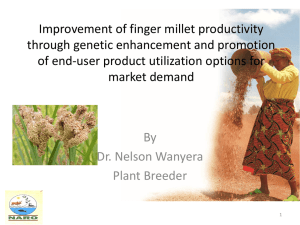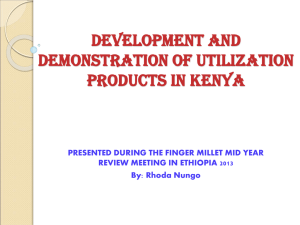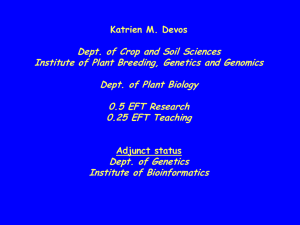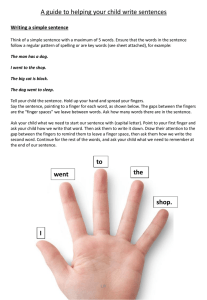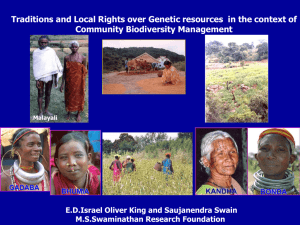SCREENING AND TESTING FINGER MILLET VARIETIES FOR
advertisement
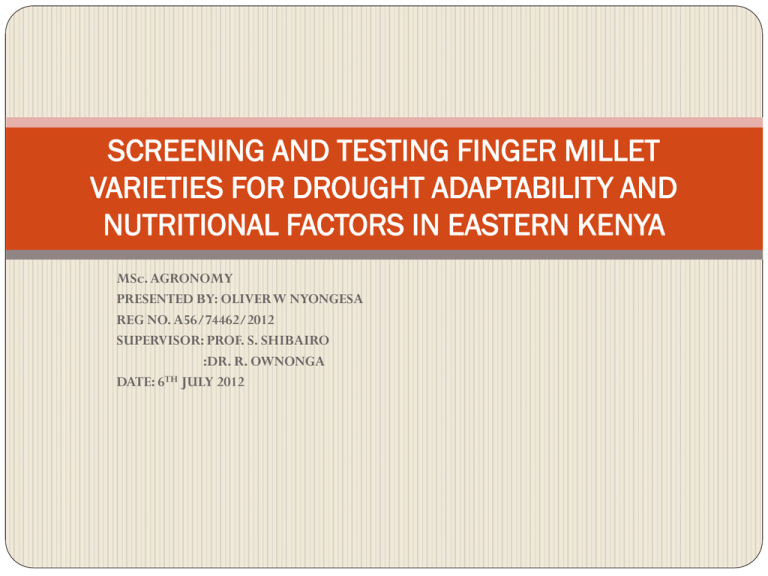
SCREENING AND TESTING FINGER MILLET VARIETIES FOR DROUGHT ADAPTABILITY AND NUTRITIONAL FACTORS IN EASTERN KENYA MSc. AGRONOMY PRESENTED BY: OLIVER W NYONGESA REG NO. A56/74462/2012 SUPERVISOR: PROF. S. SHIBAIRO :DR. R. OWNONGA DATE: 6TH JULY 2012 INTRODUCTION Finger millet (Eleusine coracana) is a neglected and underutilized crop in Africa. Its an important subsistence cereal crop & livestock feed crop mostly in eastern African region as drought resistant. Finger millet ranks 3rd in cereal production in semi-arid regions of the world after sorghum and pearl millet (Barbeau and Hilu, 1993). However its production is limited mainly by low soil fertility and anti-nutritional factors (phytic acid, oxalate & tannis) STATEMENT OF THE PROBLEM AND JUSTIFICATION Climate change effects, are undeniably affecting crop production worldwide whose severity is evident in Eastern Kenya (Hulme et al., 2001). Finger millet production may be limited by drought, low soil fertility and anti-nutritional factors (FAO 1996). There is need for improved finger millet varieties that are drought tolerant, early maturing, improved performance even under poor soil conditions and high nutritional factors that can be adopted to curb the adverse effect of drought and low fertility to increase food security. OBJECTIVE OF THE STUDY • OVERAL OBJECTIVE Establish status of finger millet and screen varieties for drought adaptability and nutritional factors in drought prone ecological regions of Eastern Kenya as a strategy to combat food insecurity and climate change. • SPECIFIC OBJECTIVES 1. To determine the current status , constraints and opportunities 2. 3. of finger millet production. To screen finger millet varieties for adaptability to drought and low soil fertility conditions. Determine the nutritional and anti-nutritional factors affecting taste and preference of finger millet. HYPOTHESIS Farmers have valuable information that can be used to increase finger millet production. Finger millet varieties are adaptable to drought and low soil nutrient conditions. Anti-nutritional factors such as tannin, phytic acid and oxalates are effecting negatively the preference of finger millet as a cereal crop. METHODOLOGY Site: Research will be conducted in two sites of Eastern Kenya; Machakos (High potential) and Kitui (low potential). Study will comprise of both survey & field experiment a. Field survey Survey will be conducted for objective one by administering a developed questionnaire to 120 selected farmers with help of local agricultural Ext’ officer. Cont’ b. Field experiment • RCBD with a split-plot arrangement replicated three times will be employed. • Sites being the main plot, varieties as sub plot and treatments (subsubplot). • Twenty different varieties both improved and local varieties will be assessed. A plot sizes of 5m by 4m and spacing of 30cm by 15cm will be used. Varieties used i. ICRISAT varieties: KNE- 1034, KNE-497, KNE-814, KNE-689, KNE-741 & KAL, ii. KARI VARIETIES: P-224, U-15, Gulu-E, Okhale-1, P-228, KAT FVM-1. Cont’ iii. LOCAL VARIETIES: Eastern variety; wembee, Teso varieties –Ebunit & Ebuluu, Kisii varieties - Enyakundi & Emarage, Bungoma varieties-Nanjala brown & Emumware and Busia variety-MS Treatments i. Fertilizers (T.S.P40kgs/ha & C.A.N 50kgs/ha) ii. Organic manure (cow manure) 10tones/ha iii. Absolute control Recommended agronomic field practices for finger millet will be observed during the growing season. cont’ Data to be collected Rainfall, temperature and soil moisture data will be collected at different growth stages to quantify the degree water of stress. Above ground biomass and root biomass will be taken at different growth stages. At harvest, yield components will be determined. Nutritional contents and anti-nutritional factors will be analyzed qualitatively in the lab. Data analysis Survey data Will be analyzed SPSS. Field and laboratory data will be subjected to Analysis Of Variance (ANOVA) suing GENSTAT13th edition (2011) WORK PLAN ACTIITIES Concept note development Proposal development & presentation Survey Land preparation & planting of season 1 Data collection & entry Land preparation & Planting season 2 Data collection & entry Data analysis & thesis writing J J A S O N D J F M A M J J A S EXPECTED OUTPUT Determine and recommend better performing finger millet varieties that are drought tolerant with an improved nutritional factors Publish and present at least one paper Thesis BUDGET NO ACTIVITIES AMOUNT(ksh) 1. Survey activity 180,000 2. Leasing land for two sites for two seasons 8,000 3. Land preparation 10,000 4. Seeds acquisition 12,000 5. Fertilizers & manure 5,400 6. Planting 10,000 7. Thinning & gapping 6,000 8. Technical assistance 50,000 9. Laboratory analysis 100,000 10. Transport & communication 50,000 11. Miscellaneous 10,000 12 Contingency 10% 0.1*441,400 = 44,140.00 Grand total 485,540.00 THANK YOU

